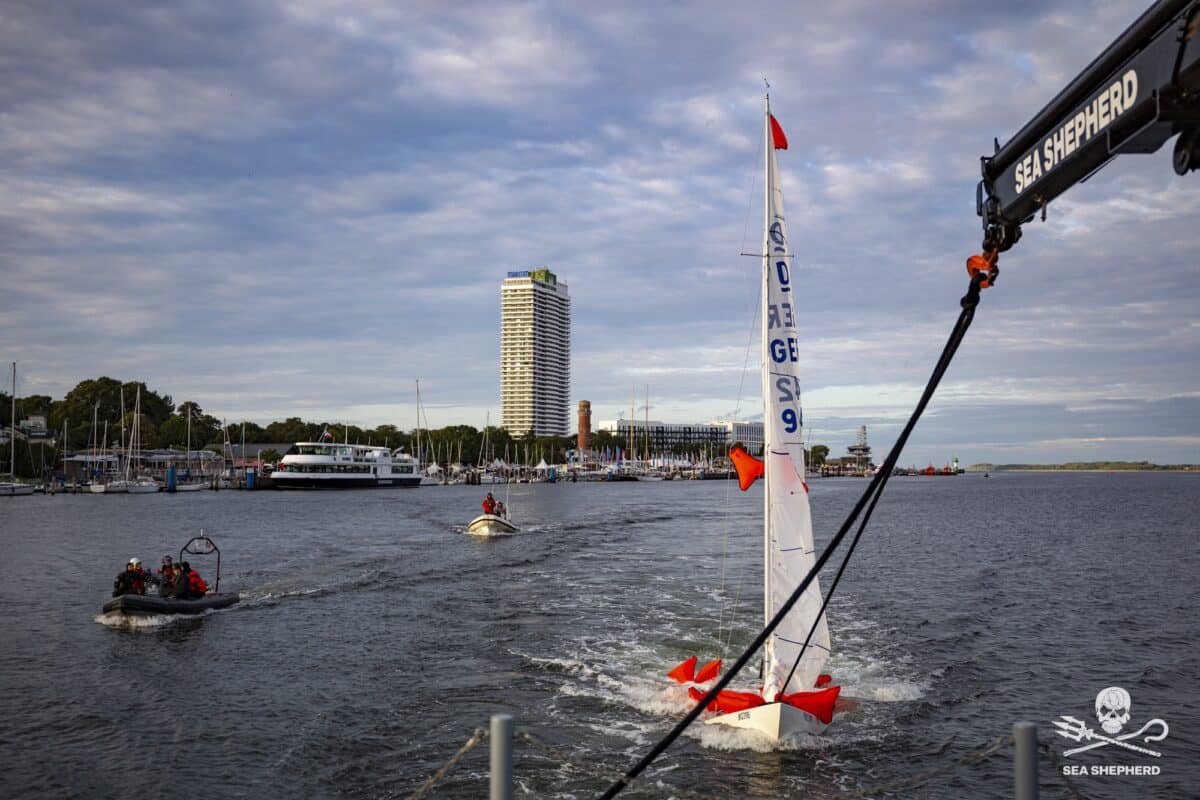It’s late afternoon on the golf course of the Travemünde Week. The sailors have already left the regatta course, a grey motorboat has taken up position as it begins to bubble up on the surface of the water in front of the Brodten cliffs. A red air bag pops out of the gray into the light, followed by a mast top. Slowly, the rig and sails rise: a “D” becomes visible, the nation identifier “GER” and finally the sail number “942”. Divers in wetsuits circle the sail, shouting commands over to the gray motorboat. The hull of the emerging boat remains just below the surface of the water. A rope is thrown over and the yacht is towed by the motorboat.
What looks like a scene from a spy thriller is the salvage operation of the non-profit organization Sea Shepherd, the initiative for the protection of marine ecosystems. The action is controlled by the “Triton”, the 23-meter-long flagship of the organization, which was taken over by the Royal Police of Gibraltar last year. During the Travemünde Week, the crew of the Baltic Sea Campaign will be on site with the “Triton”. During the Travemünde Week, the crew of the Baltic Sea Campaign will be on site with the “Triton”. In recent weeks, Sea Shepherd has tracked down and recovered ghost nets near the coast. More than 1,000 kilograms of old fishing gear could thus be removed from the Baltic Sea. Now the marine conservationists have succeeded in making the “thickest catch”.
With her “Triton” and all the diving equipment, Sea Shepherd was in the right place at the right time. On Tuesday of the Travemünde Week, a crew of the International German Championship of the Dragon Class threw it on its side in a stormy gust. The water shot into the cockpit so fast that the yacht could not be held and sank. While the crew was picked up unharmed by a THW lifeboat, the kite sank to a depth of 14 meters. “We were asked if we were able to recover the boat,” says Florian Stadler, campaign manager at Sea Shepherd. Although the organization does not specialize in salvaging boats, she dared to do so: “We saw this as a good training session for our divers,” says Stadler. When the green light came from the dragon owner for salvage, it started.

Foto: Slowly the dragon apeared above water again. Katie Maehler/Sea Shepherd
“Based on the position data we had from THW, we searched for the boat with a scan of the seabed, taking into account wind and waves that could have driven the shipwreck away, and then found it after an hour. The boat stood upright on the bottom, the top of the mast was only a few meters below the surface of the water,” Stadler reported. After inspecting the situation under water, a salvage plan was drafted. Straps were placed around the kite, lifting bags were tightly attached to the hull and rig. A total of 30 bags with a lifting capacity of 2500 kg were filled with air under water and finally ensured that nine-meter-long long keels lifted and surfaced.
Stadler: “When we got it so far out that we could tow it, we pulled the boat to the harbor with fluttering sails.” There, the kite was hung on the crane hook, pumped empty and then handed over to an acquaintance of the owner in a buoyant state and without visible damage. Since Sea Shepherd is financed exclusively by donations, there will be no invoice for the salvage operation. However, the organization has attracted attention and wants to continue it with an open ship of the “Triton” to the TW final. At the location at the car ferry on the Priwall, Sea Shepherd will present the possibilities of the sea rescuers from 10 a.m. to 6 p.m.
